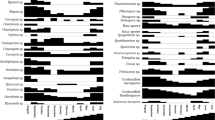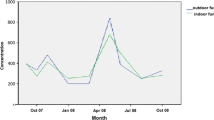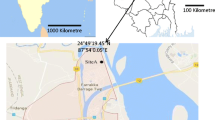Abstract
In this study, the effect of relative humidity, temperature, and wind on airborne fungal allergens in the 11 different districts of Manisa City was investigated from January 2004 to December 2005. The aim of this study was to conduct a survey to get to know the relation between wind, temperature, and relative humidity and population of allergenic fungal spores in the atmosphere. A total of 792 samples were observed by using the Merck MAS100 air sampler and 12,988 fungal colonies were counted. Fourteen fungal genera could be determined; Cladosporium that was generally found as the predominant genus followed by Penicillium, Aspergillus, and Alternaria. During the entire study, seasonal variation was found to be related to atmospheric conditions especially. The optimal conditions of meteorological factors for the fungi growth resulted in the increased number of mycoflora, qualitatively and quantitatively.
Similar content being viewed by others
References
Adhikari, A., Sen, M. M., Bhattcharya, S. G., Chanda, S., et al. (2004). Airborne viable, non-viable and allergenic fungi in a rural agricultural area of India. The Science of the Total Environment, 326, 123–141. doi:10.1016/j.scitotenv.2003.12.007.
Afzal, M., & Mehdi, F. S. (2002). Atmospheric fungi of Karachi city. Pakistan Journal of Biological Sciences, 5(6), 707–709.
Asan, A., İlhan, S., Şen, B., Erkara, I. P., Filik, C., Çabuk, A., et al. (2004). Airborne fungi and actinomycetes concentrations in the air of Eskişehir City (Turkey). Indoor and Built Environment, 13, 63–74. doi:10.1177/1420326X04033843.
Barnett, H. L. (1960). Illustrated genera of imperfect fungi (2nd ed.). Minneapolis: Burgess Publishing Company.
Bush, R. K., & Portnoy, J. M. (2001). The role and abatement of fungal allergens in allergic diseases. The Journal of Allergy and Clinical Immunology, 107, 430–440. doi:10.1067/mai.2001.113669.
Colakoglu, G. (2004). Indoor and outdoor mycoflora in the different districts of the city of Istanbul (Turkey). Indoor and Built Environment, 13, 91–100. doi:10.1177/1420326X04038873.
Cvetnic, Z., & Pepeljnjak, S. (1997). Distribution and mycotoxin-producing ability of some fungal isolates from the air. Atmospheric Environment, 31(3), 491–495. doi:10.1016/S1352-2310(96)00158-6.
Domsch, K. H., Gams, W., & Anderson, T. H. (1980). Compendium of soil fungi (Vol. 1–2). Academic Press.
Fang, Z., Ouyang, Z., Hu, L., Wang, X., Zheng, H., Lin, X., et al. (2005). Culturable airborne fungi in outdoor environments in Beijing, China. The Science of the Total Environment, 350(1), 47–58. doi:10.1016/j.scitotenv.2005.01.032.
Gelincik, A. A., Buyukozturk, S., Gul, H., Gungor, G., Issever, H., Cagatay, A., et al. (2005). The effects of indoor fungi on the symptoms of patients with allergic rhinitis in Istanbul. Indoor and Built Environment, 14(5), 427–432. doi:10.1177/1420326X05058107.
Hargreaves, M., Parappukkaran, S., Morawska, L., Hitchins, J., He, C., Gilbert, D., et al. (2003). A pilot investigation into associations between indoor airborne fungal and non-biological particle concentrations in residental houses in Brisbane, Australia. The Science of the Total Environment, 312, 89–101. doi:10.1016/S0048-9697(03)00169-4.
Horner, W. E., Helbling, A., Salvaggio, J. E., Lehrer, S. B., et al. (1995). Fungal allergens. Clinical Microbiology Reviews, 8, 161–179.
Huang, C. Y., Lee, C. C., Li, F. C., Ma, Y. P., Su, H. J. J., et al. (2002). The seasonal distribution of bioaerosols in municipal landfill sites. Atmospheric Environment, 36, 4385–4395. doi:10.1016/S1352-2310(02)00322-9.
Ismail, M. A., Chebon, S. K., Nakamya, R., et al. (1999). Preliminary surveys of outdoor and indoor aeromycobiota in Uganda. Mycopathologia, 148, 41–51. doi:10.1023/A:1007195708478.
Klich, M. A. (2002). Identification of common Aspergillus species (1st ed.). Utrecht: CBS publication.
Myszkowska, D., Stepalska, D., Obtulowicz, K., Porebski, G., et al. (2002). The relationship between airborne pollen and fungal spore concentrations and seasonal pollen allergy symptoms in Cracow in 1997–1999. Aerobiologia, 18, 153–161. doi:10.1023/A:1020603717191.
Okten, S. S., Asan, A., Tungan, Y., Ture, M., et al. (2005). Airborne fungal concentrations in east patch of Edirne City (Turkey) in autumn using two sampling methods. Trakya University Journal of Science, 6(1), 97–106.
Pepeljnjak, S., & Segvic, M. (2003). Occurrence of fungi in air and on plants in vegetation of different climatic regions in Croatia. Aerobiologia, 19, 11–19. doi:10.1023/A:1022693032075.
Pitt, J. I. (1979). The genus Penicillium and its teleomorphic stages Eupenicillium and Talaromyces. London: Academic Press.
Pitt, J. I. (2000). A laboratory guide to common Penicillium species. Food Science Australia.
Sakiyan, N., & Inceoglu, O. (2003). Atmospheric concentration of Cladosporium and Alternaria spores in Ankara and the effect of meteorological factors. Turkish Journal of Botany, 27, 77–81.
Samson, R. A., & Pitt, J. I. (2000). Integration of modern taxonomic methods for Penicillium and Aspergillus classification. Amsteldijk: Harwood Academic Publishers.
Samson, R. A., Hoekstra, E. S., Frisvad, J. C., et al. (2004). Introduction to food and airborne fungi. Holland: CBS Publication.
Shelton, B. G., Kirkland, K. H., Flanders, W. D., Morris, G. K., et al. (2002). Profiles of airborne fungi in buildings and outdoor environments in the United States. Applied and Environmental Microbiology, 68, 1743–1753. doi:10.1128/AEM.68.4.1743-1753.2002.
Singh, J. (2001). Occupational exposure to moulds in buildings. Indoor and Built Environment, 10, 172–178.
Su, H. J. J., Chen, H. L., Huang, C. F., Lin, C. Y., Li, F. C., et al. (2002). Milton DK. Airborne fungi and endotoxin concentrations in different areas within textile plants in Taiwan. Environmental Research Section, 89, 58–65. doi:10.1006/enrs.2002.4345.
Author information
Authors and Affiliations
Corresponding author
Rights and permissions
About this article
Cite this article
Kalyoncu, F. Relationship between airborne fungal allergens and meteorological factors in Manisa City, Turkey. Environ Monit Assess 165, 553–558 (2010). https://doi.org/10.1007/s10661-009-0966-x
Received:
Accepted:
Published:
Issue Date:
DOI: https://doi.org/10.1007/s10661-009-0966-x




